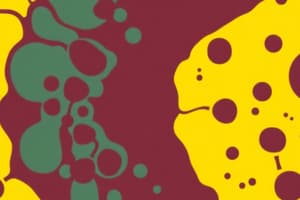Podcast
Questions and Answers
What characterizes necrosis in cell death?
What characterizes necrosis in cell death?
- Cell shrinkage and chromatin condensation
- Cell swelling and organellar breakdown (correct)
- Programmed cell death without inflammation
- Fragmentation of the cell into apoptotic bodies
Which of the following is a cause of hypoxic cell injury?
Which of the following is a cause of hypoxic cell injury?
- Inadequate oxygenation of the blood (correct)
- Autoimmune disorders
- Excessive nutritional intake
- Bacterial infections
How does aging contribute to cell injury?
How does aging contribute to cell injury?
- Through decrease in metabolic processes
- By enhancing cellular regenerative capacity
- By improving the immune response
- Through accumulation of genetic mutations (correct)
Which intracellular system is NOT particularly vulnerable to cell injury?
Which intracellular system is NOT particularly vulnerable to cell injury?
What role does cytosolic free calcium play in cell injury?
What role does cytosolic free calcium play in cell injury?
Which type of injury is caused by physical agents?
Which type of injury is caused by physical agents?
Which factor affects the cell's response to injurious stimuli?
Which factor affects the cell's response to injurious stimuli?
What is a common outcome of chemical and drug injury to cells?
What is a common outcome of chemical and drug injury to cells?
What is fatty change (steatosis) primarily characterized by?
What is fatty change (steatosis) primarily characterized by?
Which of the following conditions can lead to hepatic fatty change?
Which of the following conditions can lead to hepatic fatty change?
What does the presence of foamy cells in necrotic tissue usually indicate?
What does the presence of foamy cells in necrotic tissue usually indicate?
Which pigment associated with iron excess is described as golden brown and granular?
Which pigment associated with iron excess is described as golden brown and granular?
What occurs during pathologic calcification?
What occurs during pathologic calcification?
What is the primary effect of hypoxia on aerobic respiration?
What is the primary effect of hypoxia on aerobic respiration?
What is the outcome of prolonged hypoxia related to cellular components?
What is the outcome of prolonged hypoxia related to cellular components?
Which enzyme is stimulated due to decreased ATP and AMP levels?
Which enzyme is stimulated due to decreased ATP and AMP levels?
What phenomenon is associated with irreversible injury in ischemic conditions?
What phenomenon is associated with irreversible injury in ischemic conditions?
What process mediates damage during reperfusion in ischemic tissues?
What process mediates damage during reperfusion in ischemic tissues?
Which of the following is a common mediator of cell death associated with ischemia?
Which of the following is a common mediator of cell death associated with ischemia?
What metabolic result follows the accumulation of lactic acid in hypoxia?
What metabolic result follows the accumulation of lactic acid in hypoxia?
In irreversible cellular injury, which feature indicates severe damage to the plasma membrane?
In irreversible cellular injury, which feature indicates severe damage to the plasma membrane?
What type of injury results in the generation of oxygen free radicals?
What type of injury results in the generation of oxygen free radicals?
Which of the following mechanisms contributes to irreversible cellular injury?
Which of the following mechanisms contributes to irreversible cellular injury?
Which of the following is NOT a consequence of free radical mediation of cell injury?
Which of the following is NOT a consequence of free radical mediation of cell injury?
What type of radicals can be generated from redox reactions during normal physiological conditions?
What type of radicals can be generated from redox reactions during normal physiological conditions?
What mechanism allows carbon tetrachloride (CCl4) to induce cell injury?
What mechanism allows carbon tetrachloride (CCl4) to induce cell injury?
Which of the following components is NOT affected by oxygen free radicals?
Which of the following components is NOT affected by oxygen free radicals?
Which enzyme is responsible for generating superoxide radicals?
Which enzyme is responsible for generating superoxide radicals?
What is the typical immediate effect of carbon tetrachloride on hepatocytes?
What is the typical immediate effect of carbon tetrachloride on hepatocytes?
Which statement is true regarding reversible cell injury?
Which statement is true regarding reversible cell injury?
Which substance is involved in the hydrolysis of water leading to free radical formation?
Which substance is involved in the hydrolysis of water leading to free radical formation?
Which of the following is likely to occur within two hours of exposure to carbon tetrachloride?
Which of the following is likely to occur within two hours of exposure to carbon tetrachloride?
What are the main components that oxygen free radicals react with in a cell?
What are the main components that oxygen free radicals react with in a cell?
What cause leads to cytoplasmic eosinophilia in cells?
What cause leads to cytoplasmic eosinophilia in cells?
What is a primary characteristic of coagulative necrosis?
What is a primary characteristic of coagulative necrosis?
Which of the following changes occurs in the mitochondria during cellular injury?
Which of the following changes occurs in the mitochondria during cellular injury?
Which type of necrosis is associated with hypoxic death in the CNS?
Which type of necrosis is associated with hypoxic death in the CNS?
What is karyolysis?
What is karyolysis?
What distinguishes gangrenous necrosis?
What distinguishes gangrenous necrosis?
Which of the following accurately describes liquefactive necrosis?
Which of the following accurately describes liquefactive necrosis?
In which type of necrosis is a 'cheesy' appearance observed?
In which type of necrosis is a 'cheesy' appearance observed?
What cellular change is primarily observed during necrosis?
What cellular change is primarily observed during necrosis?
What alteration in the endoplasmic reticulum is noted during cellular injury?
What alteration in the endoplasmic reticulum is noted during cellular injury?
Study Notes
Cell Injury
- Cells strive to maintain a stable internal environment.
- When cells encounter stress, they adapt to preserve survival.
- If adaption fails, cell injury results.
Cell Death Mechanisms
- Necrosis: Occurs due to harmful conditions, characterized by:
- Cell swelling
- Protein denaturation
- Organelle breakdown
- Apoptosis: Programmed cell death, happens normally for cell turnover or during physiological processes.
Causes of Cell Injury
- Hypoxia: Insufficient oxygen, impacting aerobic respiration.
- Differs from ischemia, which also causes hypoxic injury but involves reduced blood flow.
- Physical Agents: Trauma, extreme temperatures, radiation, electric shock, pressure changes
- Chemicals & Drugs: Can disrupt cell membranes, osmotic balance, enzymes, etc.
- Microbiologic Agents: Viruses, bacteria, parasites.
- Immunologic Reactions: Immune responses can cause cell damage (e.g. anaphylaxis).
- Genetic Defects: Lead to abnormal cellular processes (e.g. Down's syndrome, sickle cell).
- Nutritional Imbalances: Protein-calorie deficiency, vitamin deficiencies, diets high in animal fats contribute to diseases like atherosclerosis.
- Aging: Natural decline in cellular function over time.
Mechanisms of Cell Injury
- Cell response to damage depends on the type, duration, and severity of injury.
- The cell type, health, and adaptability also influence the outcome.
- Four key cellular systems vulnerable to injury:
- Cell membrane integrity: Maintains ion and osmotic balance.
- Aerobic respiration: Essential for energy production.
- Protein synthesis: Creates essential proteins.
- Genetic apparatus: Contains and protects DNA.
Calcium's Role in Cell Injury
- Cytosolic calcium is kept low by ATP-dependent pumps.
- Increased extracellular calcium or release from mitochondria activates enzymes like:
- Phospholipases: Degrade cell membranes.
- Proteases: Catabolize structural proteins.
- ATPases: Deplete ATP levels.
- Endonucleases: Fragment DNA.
Oxygen Free Radicals
- Important mediators of cell death.
- Generated during:
- Ischemia
- Reperfusion
- Chemical injury
- Radiation exposure
- Normal metabolism
Ischemic and Hypoxic Injury
-
Reversible Injury:
- First effect: Hypoxia reduces ATP production, leading to:
- Calcium influx into the cell.
- Impaired sodium pump function.
- Sodium accumulation, potassium loss, and water influx, causing cell swelling.
- Accumulation of other metabolites like inorganic phosphates, lactate, and purines.
- Further consequences:
- Increased anaerobic glycolysis depletes glycogen, acidifies the cell, and leads to eosinophilia (pink staining) in cell cytoplasm.
- Ribosomes detach from ER, inhibiting protein synthesis.
- Cytoskeleton disappears, affecting cell shape and function.
- First effect: Hypoxia reduces ATP production, leading to:
-
Irreversible Injury:
- Hallmarks:
- Severe mitochondrial vacuolization and calcium accumulation.
- Plasma membrane damage.
- Lysosome swelling.
- Effects of reperfusion:
- Additional calcium-mediated injury.
- Loss of cellular components due to membrane permeability.
- Lysosomal enzymes degrade cell components.
- Final outcome:
- Myelin figure formations (whorled masses of phospholipids).
- Hallmarks:
Mechanisms of Irreversible Injury
- Progressive loss of membrane phospholipids.
- Cytoskeletal abnormalities: Proteases and calcium can disrupt the cytoskeleton, leading to cell membrane detachment.
- Toxic oxygen radicals: Released during reperfusion by neutrophils, damage cell structures.
- Lipid breakdown products: Have detergent-like effects on membranes.
Free Radical Mediation of Cell Injury
- Implicated in:
- Chemical injury
- Radiation injury
- Oxygen toxicity
- Cellular aging
- Microbial killing
- Inflammatory damage
- Tumor killing
Free Radical Generation Within Cells
- Absorption of Radiant Energy: Hydrolyzes water to form hydroxyl (OH-) and hydrogen (H.) radicals.
- Reduction-Oxidation Reactions:
- Normal metabolism produces small amounts of reactive oxygen species (ROS):
- Superoxide radicals (O2.-)
- Hydrogen peroxide (H2O2)
- Hydroxyl radicals (OH.-)
- Some enzymes, like xanthine oxidase, produce superoxide radicals.
- Metals like copper and iron participate in redox reactions that generate free radicals.
- Normal metabolism produces small amounts of reactive oxygen species (ROS):
- Enzymatic Catabolism of Oxygenous Chemicals:
- Example: Carbon tetrachloride (CCl4) is converted to a toxic free radical (CCl3.) in the liver, causing membrane lipid peroxidation.
Free Radical Effects On Cells
- Lipid Peroxidation: Damages cell and organelle membranes.
- DNA Damage: Oxidizes thymines in DNA.
- Protein Cross-Linking: Alters protein structure and function.
Chemical Injury
- Direct Interaction: Chemical binds to a critical cellular component (e.g. mercury binds to sulfhydryl groups, inhibiting ATP-dependent transport).
- Conversion to Toxic Metabolites: Chemical is transformed into a reactive compound by enzymes like P-450 oxidases in the smooth endoplasmic reticulum (SER).
- Example: CCl4 is converted to CCl3. in the liver, causing lipid peroxidation and damage to the SER.
Patterns of Acute Cell Injury
-
Reversible Cell Injury:
- Light microscopy:
- Cell swelling (hydropic changes).
- Cytoplasmic eosinophilia due to acidic pH.
- Fatty change (accumulation of lipids, often in liver and heart)
- Electron microscopy:
- Plasma membrane blebbing, microvilli distortion, loosening of intercellular junctions.
- Mitochondrial swelling and dense inclusions.
- ER dilatation, ribosome detachment, and polysome dissociation.
- Nuclear alterations, like disaggregation of granular elements.
- Light microscopy:
-
Necrosis: Irreversible cell death that occurs in living tissue.
- Morphological features are caused by:
- Enzymatic digestion of cell components.
- Protein denaturation.
- Cytoplasmic changes:
- Eosinophilia due to loss of glycogen, vacuolation, and calcification.
- Nuclear changes:
- Karyolysis: DNA digestion, leading to fading of the nucleus.
- Pyknosis: Nuclear shrinkage and increased basophilia (dark staining).
- Karyorrhexis: Fragmentation of the pyknotic nucleus.
- Morphological features are caused by:
Types of Necrosis
- Coagulative Necrosis: Cells maintain structural outline, seen in hypoxic death in most tissues (except brain).
- Enzymes are denatured, preventing rapid hydrolysis.
- Affected tissue appears pale and firm.
- Example: Myocardial infarction.
- Liquefactive Necrosis: Caused by bacterial or fungal infections, or hypoxic death in the central nervous system.
- Hydrolytic enzymes break down cells, creating a liquid, viscous mass.
- Affected tissue appears soft and liquefied.
- Gangrenous Necrosis: Not a distinct type of necrosis, but a clinical term:
- Ischemic coagulative necrosis with superimposed liquefactive necrosis due to infection.
- "Wet gangrene" refers to infection in ischemic tissue.
- Caseous Necrosis: Characteristic of tuberculosis infection.
- Cheese-like, white appearance of the necrotic area.
- Cells are completely destroyed, leaving a granular debris.
Abnormal Cellular Accumulations
- Fatty Change (Steatosis): Abnormal triglyceride buildup within parenchymal cells.
- Most common in liver (reversible).
- Also occurs in heart, muscle, kidney, and other organs.
- Caused by toxins, diabetes, protein malnutrition, obesity, and anoxia.
- Occurs when there are defects in fatty acid entry, synthesis of lipoproteins, or lipid export.
- Grossly, the liver enlarges and becomes yellow.
- Cholesterol and Cholesterol Esters:
- Macrophages ingest lipid debris, forming "foamy cells".
- In atherosclerosis, smooth muscle cells and macrophages are filled with cholesterol esters.
- Xanthomas: Fat-filled subcutaneous macrophages, appearing as white nodules.
- Proteins:
- Less common than lipids, may accumulate in kidneys in certain diseases.
- Glycogen:
- Accumulates in disorders of glucose or glycogen metabolism appearing as vacuoles.
- Pigments: Colored substances.
- Melanin: Dark pigment produced by melanocytes, responsible for skin and hair color.
- Hemosiderin: Golden-brown pigment derived from hemoglobin, accumulates with excess iron.
Pathologic Calcification:
- Abnormal calcium salt deposition with other minerals.
Studying That Suits You
Use AI to generate personalized quizzes and flashcards to suit your learning preferences.
Related Documents
Description
This quiz covers key concepts related to cell injury, including the mechanisms of necrosis and apoptosis. Additionally, it explores various causes of cell injury such as hypoxia, physical agents, and microbiological influences. Understand the physiological challenges cells face and the processes leading to their demise.




